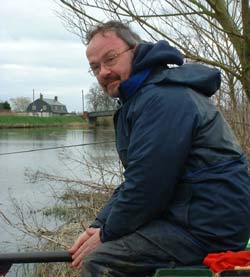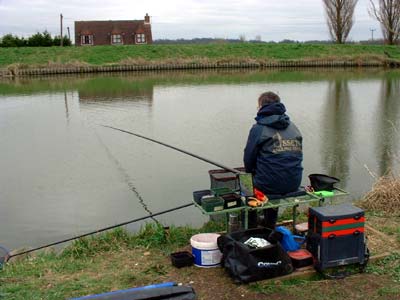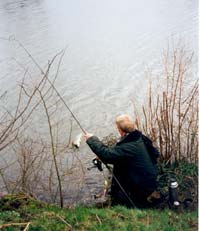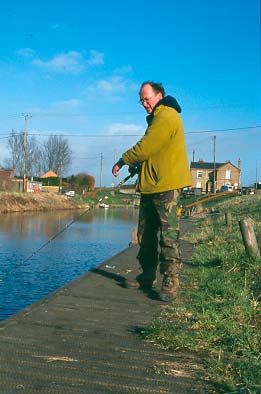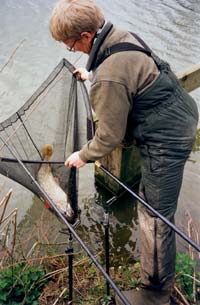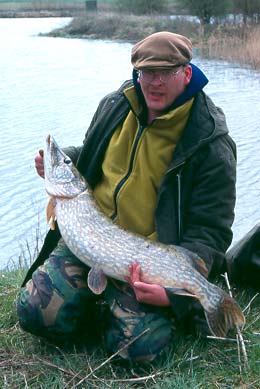Journalist and predator angler fell in love with the Fens when he moved to Norfolk five years ago. In a new monthly series, exclusive to FISHINGmagic, he gives us a glimpse of this unique landscape and some of the characters who fish it.
Who could fail to be inspired by a drive along the winding road that hugs the Ouse between Ten Mile Bank and Denver. It’s a big river. A daunting river. A river with mile upon mile of all but untapped potential. And once the summer visitors depart, those of us who target its elusive predators have it almost all to ourselves.It seems hard to believe these days but it wasn’t always like this. Not so long ago the matchmen came by the busload to fish the Fens. Nowadays, the 1500-peggers are history and what’s left of the open circuit has long since decamped to the carp pools. The glory days But there are still those who remember the glory days of the 60s and 70s on the Middle Level, Ten Mile Bank and the Witham. And a handful of Yorkshire diehards like Sheffield builder Tom Jaffray still make a pilgrimage to the Fens, where the banks are all but deserted these days.
In the 1960s much of the Fens were the preserve of the 20,000-strong Sheffield Anglers Association, which was a passport to fresh air for tens of thousands who slogged and sweated down South Yorkshire’s pits or in the city’s steelworks. “My first fishing down here would have been when I was about eight years old – 1954 that was,” said Tom, now 56. “This river was teeming with roach then. “Whenever we come down here it feels like we’re coming home, I was brought up fishing down here.” A decade later and he was up against the likes of Billy Lane, Freddy Foster and Ivan Marks. “I never knew anyone smoke as many fags as Marksy,” smiled Tom. “No wonder he needed a heart by-pass. “Round his basket it would look like gravel but it wouldn’t be gravel – it was all the filter tips. “I used to say to him: `If tha ever falls in Ivan just grab a couple of handfuls and tha’ll float.” Unbelievable, but there used to 40 coaches, 6 trains…….. The stories seem almost unbelievable now. Another world to those of us who fish the Fens today for the solitude and marvel at the seemingly limitless elbow room. “I’ve seen 40 coaches at Three Holes from different parts of Sheffield, Rotherham and Chesterfield,” said Tom.
“And they were all full of fishermen as well, there wouldn’t be another passenger.” The coaches headed for Wisbech Market Place, where the 1500-peggers on the Middle Level like the Haig & Haig Gala would be drawn. The trains were bound for Lincolnshire and the Witham, which once had stations along its banks. They even had their own tackle dealer on board. “Old Ernie Stamford used to come along the train with a brown suitcase full of tackle – hooks, line, shot, disgorgers,” said Tom. “Every steelworks angler worth his salt bought his bait and tackle from him.” The swingtip was revolutionary Ernie’s biggest seller had a three-month waiting list. An eight-foot rod specially designed for the deadly new tactic which had revolutionised matches – the swingtip rod. Tom’s still got his, bought in the days when seven quid was more than a week’s wage to the average miner or steelworker. Legering for bream swept the board on the wide drains and rivers, where previously anglers were hard-pushed to float fish more than a rod’s length or two out. Legend has it the new method was discovered by accident by Boston tackle dealer Jack Clayton. “His split cane top broke and at the same time he got a bite and it lifted up,” said Tom. “It was awesome when it was first brought out.” Now the big shoals which lived in the middle were within reach regardless of the weather and match weights soared accordingly. But while the keepnets bulged with bream the boom would soon be over. ************************************ Tom’s lollipop float’s not moved for half an hour today. And just a half dozen roach have found their way into his keepnet. The mid 70s were a turning point Ask anyone who remembers and they’ll tell you the mid 1970s were a turning point in the Fens. Match weights went into decline and by the end of the decade, the fishing had declined to a shadow of its former self. Fingers were soon pointed at the obvious scapegoat. Tom was there the day the first zander were released into the Relief Channel at Stowbridge. He saw history being made on the newly-dug channel’s wind-swept banks. “We were staying at what’s now the Heron Pub, right by the bridge – it used to be a house then,” he said. “We were on the Relief Channel the day they came along with their tanks and their trailer. “There was this fisheries scientist there. He said they were doing it as an experiment. “He said it would be good for us anglers because these fish would break the shoals up and keep the fish more active – and they’d be contained in the Relief Channel.” The death penalty was imposed Within a few short years, the newcomers were spreading rapidly throughout the Great Ouse and Middle Level systems. Despite an outcry from predator anglers, who had already begun targeting the new species, the prosecution was an open and shut case. Silver fish were declining at the same time an alien predator was on the rampage. The death penalty was imposed and the same water authority which introduced the zander launched a culling programme. Tom wasn’t convinced at the time. He isn’t today. He thinks the wrong bunch of foreigners got the blame and the fledgling Common Market and its Common Agricultural Policy have a lot to answer for. “When we joined the Common Market, in ’73 I think it was, there were massive subsidies. “Outside every farm when we were travelling down there were piles of yellow bags, blue bags, orange bags – there were mountains of fertiliser. “And they were shovelling it in because it was only 50p a bag.” The fertiliser didn’t stay on the land, of course. A lot of it found its way into the water. “I was fishing the Middle Level Drain one day and a crop spraying plane flew over,” said Tom. “They were supposed to turn it off when they went over water but he didn’t and I got covered with this orange stuff, it was all over me.” The wheel has almost turned full circle now. Tighter controls on nitrate use are in the pipeline, at a time when more and more people want chemical-free food. Recovering, but more bait needed The Fens are recovering, slowly but surely. All that’s missing today are the anglers – and all the bait they used to throw in. “There’s no bait going in today. In the 1960s and early 70s there’d be a thousand anglers on the Middle Level Drain on a Sunday from June 16th right through to the end of September. “And the standard kit was half a stone of groundbait, mashed potato, bran – we all had these secret ingredients and everyone used to bring squats for bream fishing, home bred gozzers.” Gozzers were an enigma. Legend has it Ivan Marks or one of his travelling companions coined the phrase for a maggot as soft as a wasp grub, which seemed to stick to the lips of any Fen bream which sucked one in. It had to be a fresh pigeon, to attract the right kind of fly. It had to go out after dark in a biscuit tin. And you had to get it in before first light – to make sure the right fly blew on it. No one breeds gozzers in their outside privvy any more. No-one’s got a privvy come to that. And no one feeds the fish like the miners and the steelworkers used to. Tons of groundbait, gallons of maggots are missing Today’s tackle shops seem more like deli counters with all their designer baits. The days when anglers’ bait formed the major food source in the Fens are as much a part of history as the swingtip. “Imagine a thousand Sheffield anglers, with half a stone of groundbait each – what tonnage of groundbait is that?” Said Tom. Mike and I look at each other and shake our heads. We can’t help with the maths but you’ve got to agree that’s a lot of grub going in.
“No one used to take bait home with them because there were no fridges for bait in them days.” Tom’s proved the feed’s the thing with some big catches of bream and tench from the Middle Level and Cut-Off, after baiting a swim over several days. Tom’s got another theory. Things would have been very different if 60s matchmen had had the tackle available to their counterparts today – like the 11-metre carbon pole he’s using to hold the lollipop float back in the flow, over the shelf where the river drops away to nearly 15 feet of water. “People wouldn’t have gone to Ireland because the 200lb catches would have been here,” he said. “If you’d had the poles, fine lines and sharp hooks we’ve got today you’d have emptied the Middle Level. You’d have needed three keepnets.” The season’s ticking away. I could have listened to Tom all day but it’s time to make my excuses and return to my piking. Past Ten Mile village and along the winding road, I hardly see another soul. But I can picture the coaches, the miners and the steelworkers, all 12 yards apart with their swingtip rods and their gozzers. And Ivan Marks perched on his basket. Surrounded by fag ends. Dr Livingstone? No, it’s Chris Hammond
Dr Livingstone I presume..? Not quite – it’s Chris Hammond. “We should get some here mate,” he says as we survey a forgotten backwater fringed with Norfolk reed. Chris’s confidence is as infectious as his smile. He likes seeing big fish caught but he’s not too bothered whose landing net they end up in. You have to clamber onto a rusty old barge to fish the place. There’s a distinct lack of neatly manicured swims. But we’ve got it to ourselves and on a mild March morning I’m half convinced we’ve died and gone to heaven. The old hulk shudders as we board her but she’s well and truly grounded. She’ll never see open water again. Two deadbaits are soon on the edge of a reedbed 30 yards away. Chris thinks we’re on for a big fish. They come in here to spawn. The season’s ticking away and we’re hungry for a 20. Chris nailed two before Christmas, then a hand injury sent him to the subs bench just as he was on a roll. I’ve been robbed when two likely looking contenders went 19:12 and a 19:14. I wonder if I’m going to set the record straight as my float lays flat. But a three pound jack’s got other ideas, as it twists my trace up and neatly impales the hooks on what’s left of my landing net. I’m still cutting the trebles out of the mesh as Chris leans into one around twice the size. A couple of missed runs later it’s time for a conflab. The bigger fish ought to be here but we’re sceptical. Maybe they’re in the deeper water around the corner.
There’s five feet of water here instead of three. It feels so right I start to think it might even happen. I drop one bait in the channel a rod length out and blast the second 40 yards into the bay. “This is the one!” We get another jack each and miss a succession of twitchy runs. I wonder if they’re from the schoolie zander which abound in the river, as I sharpen the hooks and send another joey mackerel in their direction. Then the float on the near rod in the channel shudders and moves off. I pull into it and shout out: “This is the one!” As the hooks go in I feel the fish that makes it all worth it on the end. All the blanks, all the miles of travelling, all the jacks, and all the nights when I get the gear out of the car and wonder why I bother trying to be a piker. I’m not a number cruncher but I haven’t had a 20 since the previous March. And a little voice in the back of my head is chirping: “If you lose this one, it might be another year…” I’m leaning into her as hard as I can but I’ve still got to backwind. I give line grudgingly but this old girl is something else. It seems an age before the float finally reappears. Chris is balancing on a mooring, net already sunk in the water. But every time I get her close, she surges off again. She looks a big double length-wise we agree, as she kites past the net for the third time. I can’t remember a fish which fought this hard and I’m starting to wonder who’s calling the shots and whether I’m ever going to land her. I’ve got no choice but hold her hard as she makes a headlong rush for the moorings but she runs out of steam as the rod locks up and her tail flaps on the top as I turn her back towards us.
We know she’s a 20 now. There’s no justice in the world if a fish that fought like that doesn’t spin the Avons into the hallowed territory. “You’re beautiful,” I tell her out loud as I turn the hooks out. I blush with embarrassment but Chris doesn’t hear. He’s up the bank grabbing his Nikon as I slip her into the weigh sling. The dial says 21: 04. That means 20:06 with the sling deducted. Chris knows he’s come up trumps and made my season. We punch the air, shake hands and it’s time to say goodbye. She tenses up for a second as I slip her back and then she’s gone in a swirl and a cloud of silt. STOP PRESS You could even sample the delights of fishing the Fens around King’s Lynn for a whole season for free. Our friends at King’s Lynn AA have put up a junior and senior club card YOU could win in a special FISHINGmagic competition. All you have to do is e-mail us the answer to this simple question and if you get it right, we’ll add your name to our draw for a free season’s junior membership and a free year’s senior membership. The question is: Who invented the swing tip..? Was it: A/ Jack Clayton Get your entries in by April 7 and make sure you tell us whether you’re a junior (under-16) or a senior. The editor’s decision is final, winners will be notified by April 15 and club books will be posted by the start of next season. Email answers to editor@fishingmagic.com. |











